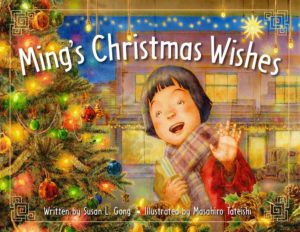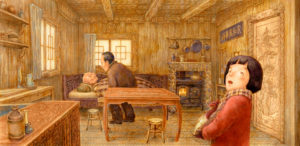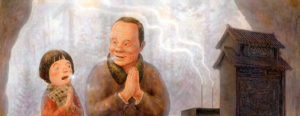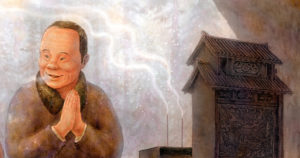 Guest post by Masahiro Tateishi, the illustrator of Ming’s Christmas Wishes
Guest post by Masahiro Tateishi, the illustrator of Ming’s Christmas Wishes
Ming’s Christmas Wishes is a picture book for children; however, it addresses a deep societal issue that is still highly relevant in today’s world. While I lived in Hawaii, I had an experience which helped me develop a strong passion for sharing important historical stories that many people might have forgotten. After I first read Susan L. Gong’s script for this book, I extensively studied the history of Chinese immigrants in the United States. And my passion was revived. I really wanted to tell this story to young readers.
The book tells the story of an immigrant Chinese family, living in California in the 1930s. In the 19th and early 20th century in the United States, Chinese and other Asian immigrants were the targets of severe racial discrimination. Their basic human rights were neither respected nor protected. They were ridiculed, harassed, and abused. This was especially cruel for those who immigrated to the United States, a land in which they expected to find a better life for themselves and their families. No wonder Ming’s mother was so adamantly against celebrating Christmas, a major tradition of white Americans who hated her people so much.
Ming is too young to understand the true source of the racial discrimination and innocently hopes that if her family becomes “American”, she will be welcomed and accepted in her school and community. Ming was born in the United States, and unlike her father and mother, she has not seen or felt the greatness of her cultural heritage. All she knows is that she is a poor girl in a small town and that she is treated differently because of her race. In Ming’s circumstances, it is extremely difficult for her to develop proper appreciation for her cultural and racial background or to draw strength from it.
In the story, Ming’s father takes her to Uncle Lin’s tiny cabin near Yosemite National Park. In this humble place, Ming starts to see a glimpse of her cultural heritage. When I first read Susan Gong’s script, I was a bit confused by how she wanted the interior of this humble cabin to be intricate and artistic. There was a mention of a door frame with a dragon carving, window frames with a phoenix and plum tree blossom engraved, and other decorative objects. But as I researched and pondered the meaning of each object, I started to see how I could use those objects as symbols to convey the beautiful messages contained in this wonderful story. I would like to briefly explain what I tried to communicate from decorations that I drew in Uncle Lin’s cabin.
- Door with a prodigious pine tree: A door inside Uncle Lin’s cabin displays a carving of an enormous pine tree that is almost touching the sky. In Chinese culture, the pine tree represents the longevity of a good life. I wanted the size of the pine tree to represent the collective desires of Chinese immigrants who were desperately seeking a good and long life. Additionally, two guardian dragons were carved on the door frames to protect their precious hopes.
- Window frames with plum tree blossoms: The window frames of Uncle Lin’s cabin are carved with plum tree blossoms. Chinese plum trees represent the hope and bravery of Chinese immigrants who endured the harsh winter to see a brighter spring, which symbolizes a society where peace and happiness can be achieved.
- Phoenix above the window lintel: A Chinese phoenix is engraved above the window lintel. The phoenix represents many Chinese immigrants who stayed virtuous and graceful despite their extreme hardship.
- Chinese zodiac signs: At the top of a wall, there are carvings of 12 Chinese Zodiac animals. Each animal represents a year from the Chinese 12-year time cycle. It shows the circular nature of yin (dark) and yang (light), indicating that hard times will not last forever, and that better times will come as they patiently wait for it.
- Children eating a peach from a peach tree: This image is etched on top of the chest cabinet in Uncle Lin’s cabin. Like the pine tree, the Chinese peach tree symbolizes a long and healthy life. This imagery shows Chinese immigrants’ sincere desires for their children to have a better and greater life.
As I was illustrating the cabin scenes, I felt every stroke of Uncle Lin’s carvings represented the prayer and hope of many Chinese immigrants who so desperately wished for a better life. And they did so with dignity and integrity.
After the visit to Uncle Lin’s cabin, Ming’s father takes her to a small wooden altar hidden inside the hollow of a giant sequoia. The theme of prayer is more explicit in this part of the story. The back of the altar features the four guardian beasts who are protectors of the world: White Tiger, Azure Dragon, Black Tortoise, and Vermilion Bird.
As her father lights the incense and worships at the altar, Ming asks what is in his heart as he prays. I wonder what was in the hearts of all those who came to the altar. Beaten down by discrimination, I’m sure despair filled the hearts of so many Chinese immigrants. Yet, they came to the mountain and prayed. They knew changes would come very slowly, but perhaps their prayers gave them hope and courage to endure their hardships. As I illustrated the mountain scenes, I paid particular attention to the contrast between cold winter snow and the warmth of giant sequoias. I wanted to help the reader feel the comfort and refuge that those early immigrants felt as they came to Yosemite. As Ming’s Grandfather said, “Here, we’re not foreigners. Here we are men, a small part of nature’s greatness.” Her grandfather loved the mountain so much that he called it his mountain.
In the world we live, how many people are offering a similar prayer that Chinese immigrants offered so long ago in Ming’s Grandfather’s mountain? How many people are still fighting against the same racial discrimination that tormented Asian immigrants over 100 years ago? I believe the release of this book is very timely and the message speaks truth to so many people who live in our world today. Just like Uncle Tom’s Cabin by Harriet Beecher Stowe reminds us of courageous African Americans who fought for freedom, I hope Ming’s Christmas Wishes will remind us of the prayers and hopes of early Chinese immigrants who valiantly endured senseless prejudice and discrimination.
A professional artist with a BFA from Brigham Young University, Masahiro Tateishi specializes in digital and traditional painting and illustration. He also does calligraphy, graphic design, and mural painting. He was born and raised in Sasebo, Japan next to a beautiful mountain and waterway. He spent his childhood playing in the woods and at night falling asleep to the sound of the flowing river. Consequently, he is fond of nature and animals and that is often reflected in his work. His art has been used by animal museums and wildlife centers in the USA and Japan. His art also appears in books and learning materials for children. Masahiro has lived in Hawaii and Utah. He currently lives in Fukuoka, Japan. To learn more about him, please visit www.masapaints.com and www.masaandpapa.com.



